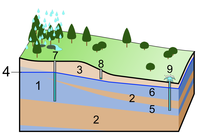
Photo from wikipedia
Subsurface deformation due to long terms of groundwater drawdown from 1960 to 1997 and groundwater recovery from 1997 to 2016 in the upper part of the Bangkok multi-aquifer system and… Click to show full abstract
Subsurface deformation due to long terms of groundwater drawdown from 1960 to 1997 and groundwater recovery from 1997 to 2016 in the upper part of the Bangkok multi-aquifer system and their possible effects on substructure stability were analyzed. The updated groundwater monitoring data show a linear recovery trend with a full recovery by 2031 in the study aquifer. Subsurface deformation was calculated using FEM transient coupled pore pressure/effective stress analysis by Abaqus. It was found that the groundwater drawdown from 1960 to 1997 caused a subsidence of 51, 62, and 76 cm, while the following groundwater recovery from 1997 to 2016 could pull back a rebound of 9.8, 9.7, and 5.3% at the three study sites, respectively. The effects of the change in pore pressure and undrained shear strength of the clay layers on the ultimate pile capacity were studied for cases of high-rise and low-rise buildings at a selected site. It was found that the groundwater drawdown from 1960 to 1997 could cause an increasing rate of ultimate pile capacity of about 1.0–1.5% per year, while the groundwater recovery from 1997 to 2031 can cause a similar reduction rate of ultimate pile capacity.
Journal Title: Acta Geotechnica
Year Published: 2020
Link to full text (if available)
Share on Social Media: Sign Up to like & get
recommendations!